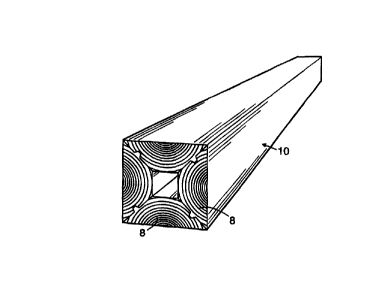Note: Descriptions are shown in the official language in which they were submitted.
CA 02284144 1999-09-17
WO 98/41370 PCT/SE98/00497
A method to produce elongated objects of wood
The present invention concerns a procedure for producing elongated wooden
objects, such as posts. The invention also concerns an elongated object
produced
according to the procedure.
The invention particularly concerns, but is not exclusive to, a procedure for
producing wooden posts that primarily uses thin timber, i.e. timber with a
major diameter
of less than 10 cm. Today, wooden posts, especially those used for making
frames, are
made of wood laminates glued together to form boards, which means that they
warp over
time, i.e. they twist and bend. Such wooden posts can also be produced by
mounting
together four boards to make what is in principle a box. Its strength is
limited and the
box will split with time.
With the help of the invention, a wooden post that has high strength, that
does not warp with time, that has the heart of the trunk facing the outwards,
and that has
few of the problems associated with knots, can be achieved. This is possible
by the
invention having the characteristics given in the claims.
The invention will be described in greater detail in the form of an example
with reference to the drawings, where Fig. 1 shows a schematic end view of
round,
unhewn timber - a tree trunk, Fig. 2 shows the rounded timber cleaved into two
parts,
Fig. 3 shows one of the parts of Fig. 2 planed to an isosceles trapezium in
cross-section
and Fig. 4 shows the elongated object made up of four pieces of timber
obtained from
two rounded pieces of timber.
Round, unhewn timber - a tree trunk 1 - is cleaved down its length along two
cleaved cuts 2. The cleaved cuts 2 are positioned so that the heart of the
tree remains in
the remnants 3. Following cleaving, two semi-circular pieces of timber 4 are
obtained,
see Fig. 2. The right-hand part of Fig. 2 shows two planing cuts 5 marked so
that,
together with the cleaved cut of the timber, they form a section that can be
imagined to
be a right-angled isosceles triangle. As can be seen more clearly in Fig. 3,
which shows
the section of timber 4 planed according to the planing cuts 5 according to
Fig. 2, the
planed cut 5 has been provided with a groove 6 and tongue 7. By cleaving the
tree trunk
on either side of the heart, which is left in the remnants 3, the planed
timber section 8
will not have a triangular shape but the shape of an isosceles trapezium. If
wished, the
short side 9 can also be planed.
Fig. 4 shows the post 10 assembled from four finished planed pieces of
timber 8. This figure shows clearly how the pieces of timber 8 are positioned
with
CA 02284144 1999-09-17
WO 98/41370 PCT/SE98/00497
2
groove 6 and tongue 7 acting against each other. The planed surfaces are glued
to each
other, suitably by means of a continuous press. As such, which does not make
up any
part of the invention, post 10 can in principle be made as long as desired by
placing an
end-splicing mill prior to the gluing and the continuous press.
By means of the invention, a better saw yield with a glued post that does not
twist or warp is obtained. The finished post has the heart of the trunk facing
outwards,
which gives a hard and even surface without the disturbance of knots and,
since the
timber dries successively and the cleaved side 2 with the heart of the trunk
attempts to
adopt a convex shape, with joints that are the subject of a self tightening
effect.
It should be understood that all sizes of rounded timber - tree trunks - can
be
used, but that the major benefits of the invention are, as noted, obtained
with thin timber,
i.e. timber with a major diameter of less than 10 cm. In the same way, the
groove and
tongue are naturally not essential for production of the post. It can also be
imagined that
timber sections with profiles whose nose angles deviate from 90° could
be cut from the
tree trunk, but in that case, a large part of the saw yield would be lost,
which in the
described example is about 70% compared with about 35% for making equivalent
posts
today.
